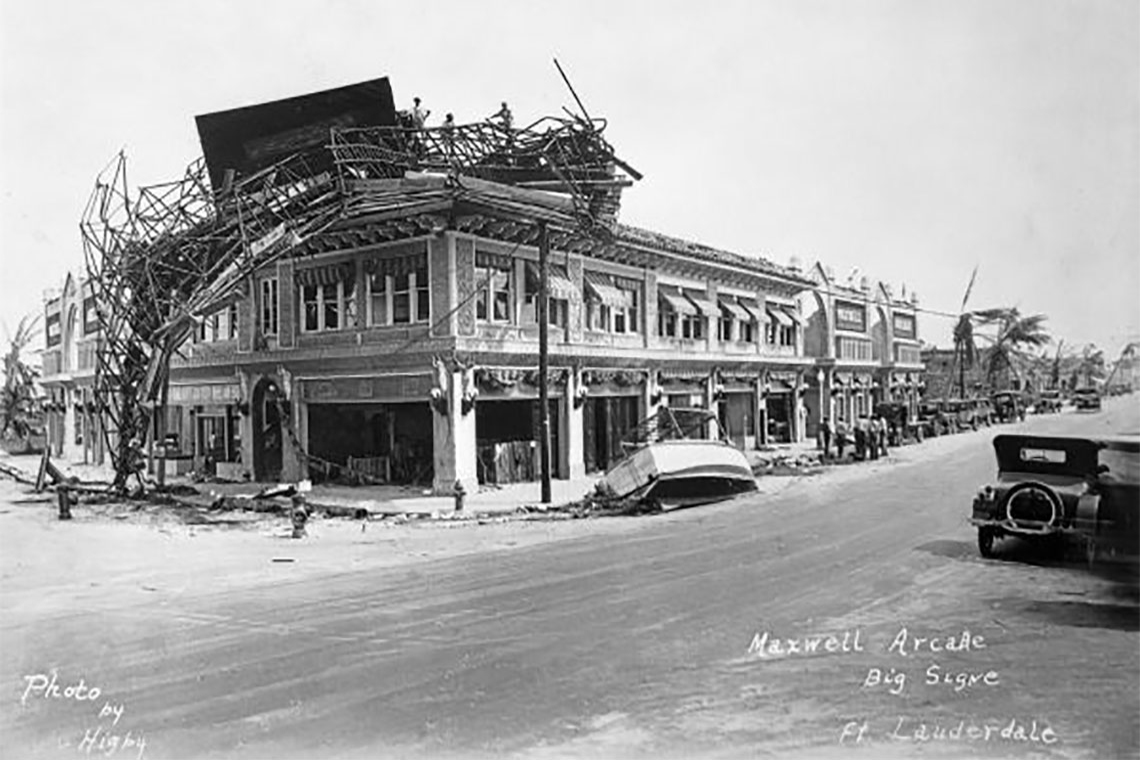No real hurricane warnings were possible in the 1920s. No text alerts on mobile phones, of course. No wall-to-wall coverage on Channel 7, because there was no TV. And very few folks had those newfangled radios.
On Sept. 17, 1926, the National Weather service had reported a tropical storm was likely to hit the Bahamas, then perhaps scrape the Florida coast. A small advisory ran in the papers the next morning. Two months previous, a mild hurricane went by South Florida, causing little damage. The Miami Herald assured its readers then about hurricanes: “There is more risk to life venturing across a busy street.”
So when at 6 p.m. on Sept. 18 a Miami weather official received a hurricane warning from Washington, there were few options to get the word out.
Soon, the winds began howling, the rain came pounding and a Herald editor sent a young reporter over to the Weather Bureau “to find out what the hell’s going on.” The reporter was clobbered by debris and took refuge halfway there. (The reporter, a Danish immigrant named Henry Reno, would survive the hurricane and go on to father three children – including the first woman to become attorney general of the United States, Janet Reno.)
By 2 a.m. hell was unleashed upon South Florida, the roaring 150-mph winds of a Category 4 storm pounding Fort Lauderdale, Miami and everything in between. Between 325 and 650 people were reported lost, and 800 others were never accounted for.
Property losses were the worst in U.S. history. In Fort Lauderdale, 3,500 buildings were either demolished or severely damaged. The scope is clear when you factor in our population at the time – only 12,000.
This was the era before storms got names. But this got one after: The Big Blow. Accounts from newspapers and historians like Stuart McIver and Deborah Work have preserved eyewitness accounts from the time.
“Two schoolteachers, Nell Hudlow and a friend, had arrived that day in Fort Lauderdale to start new jobs,” wrote McIver in the Sun-Sentinel. “When they checked into the Broward Hotel on Las Olas Boulevard, there was no mention of the hurricane. In their corner room, fronting on the boulevard, the women turned in early, exhausted from their two-day train trip from Covington, Virginia.
“‘All of a sudden the wind came up and just took the sheets off our bed, clear across the room,’ Nell Hudlow recalled. ‘Then we heard all this glass breaking. It was between 11 and 12, and we got up and looked out. The sky was all lit up. We had never been in anything like that before, and we were scared to death. Then the hotel clerk came along and knocked on the door and I said, “Is this a bad storm?” and he said, “Oh, lady, it’s terrible.’
“Skylights and windows shattered, and the water rose four feet deep in the lobby… a building inspector ordered all women and children to move to the Women’s Club at Andrews Avenue and Southeast First Street.”
In My Soul Is A Witness, Deborah Work quotes Anna Smith, from segregated Fort Lauderdale’s black neighborhood: “The city was flooded, the high tides and strong winds swept through and destroyed most of what everyone had. People were walking neck deep in water with their children on their heads.”
Hours later, near dawn, the winds calmed, the sun peeked out and people came out to celebrate the fact that they had survived. In Miami, a horrified Weather Bureau officer came running out into Flagler Street, crying out, “The storm’s not over! We’re in the lull! Get back to safety!”
It was the eye, not the end. Thirty-five minutes later, the fierce winds were back along with a storm surge of 12 feet that vaulted over canals and abutments and raced up waterways. Dozens who had ventured outside were killed.
And then the storm of 1926 kept on going, following a northwest track up to Lake Okeechobee. Weak dikes burst, unleashing a 15-foot-high wall of water on Moore Haven. Hundreds died there. Then the storm crossed the state into the Gulf of Mexico, striking Pensacola and Mobile before eventually blowing out near Gulfport, Mississippi.
Meanwhile in Fort Lauderdale there was devastation – but also little glimmers of hope. Later, Anna Smith would speak of the needed help it offered to Fort Lauderdale’s black community.
“The hurricane was bad but it was good,” she said. “See, it caused new jobs to open up for black people, who were hired to help repair and rebuild the city.”
Not only that. “White and black,” she said, “were praying together for the first time.”












